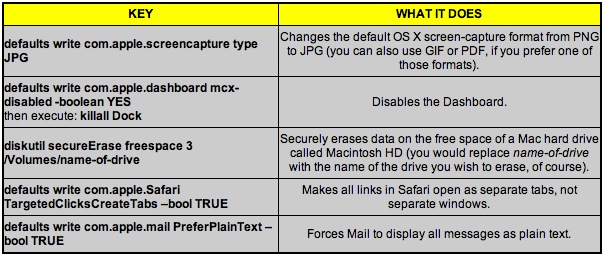apple tale (50 Things Every Mac fans Should Know)
Like a champion cyclist knows bike parts,a car buff knows model years, and a sports fan knows win-loss records, all Mac geeks worth the title must know these things.
Like a champion cyclist knows bike parts,a car buff knows model years, and a sports fan knows win-loss records, all Mac geeks worth the title must know these things.
Marketers and Madison Avenue operators like to reduce consumers to either/or "types"—paper or plastic, boxers or briefs, cotton or cashmere, Honda or Mercedes, Cristal or Bud--you get the idea. But what often fails to register in such a superficial worldview are the specific reasons behind what we choose when presented with a "this or that?" decision.
When it comes to computing, the question is Mac or Windows? And, as a Mac user, your allegiance to your platform of choice--as in marriage--isn’t entered into lightly. But once you renounce the Dark Side and join the growing legions of Mac enthusiasts, it’s not enough to maintain a casual connection to your Mac, iPhone, iPod, or Apple TV. The difference between a Mac user and a Mac geek isn’t just how attached you are to your Apple tech--or how often you publicly proclaim that attachment with logo T-shirts, "Think Different" bumper stickers, or by plastering everything you own with Apple logo stickers. Your level of geekitude depends on how deeply you strive to connect with your Mac and OS X--yeah, we know it sounds like psychobabble. The point, friends, is that being a Mac geek is distinguishable from being any other kind of tech geek, because although it helps to have some basic knowledge of technical geekery, like, say, the names of certain coding languages or the fact that Mac OS X is a Unix-type operating system, you need never have written or even seen a line of Unix code to join the ranks of Mac geekdom. All you need, really, is passion for your Apple gadgets--how you show it is up to you.
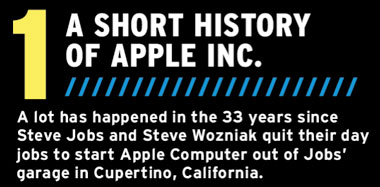
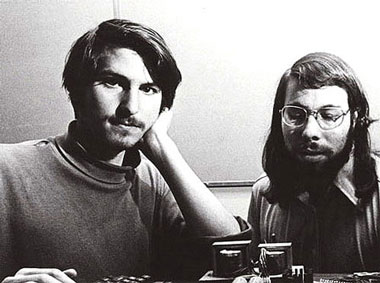
1976 - 21-year-old Steve Jobs quits his job at Atari and persuades computer engineer Steve Wozniak to quit his job at Hewlett-Packard to start Apple Computer out of Jobs’ garage. On April 1, Jobs, Wozniak, and third founder, Ronald Wayne, introduce the first Apple computer, the Apple I personal computer kit, priced at $666.66.
 1977 - Wayne sells his shares of the company back to Jobs and Woz for $800, and Apple Computer is incorporated on January 3 without him. On April 16, the Apple II is introduced at the first West Coast Computer Faire.
1977 - Wayne sells his shares of the company back to Jobs and Woz for $800, and Apple Computer is incorporated on January 3 without him. On April 16, the Apple II is introduced at the first West Coast Computer Faire.
 1980 - In May, the Apple III is released, competing with IBM and Microsoft in business computing.
1980 - In May, the Apple III is released, competing with IBM and Microsoft in business computing.
 1982 - Jobs, who started working on the Apple Lisa two years before, is pushed out of the development team because of in-fighting; he takes over the low-cost Macintosh project from Jef Raskin.
1982 - Jobs, who started working on the Apple Lisa two years before, is pushed out of the development team because of in-fighting; he takes over the low-cost Macintosh project from Jef Raskin.
 1983 - The Lisa team wins the development race, releasing the Lisa as the first personal computer sold to the public with a graphic user interface (GUI). Its high price and limited software doomed Lisa to commercial failure.
1983 - The Lisa team wins the development race, releasing the Lisa as the first personal computer sold to the public with a graphic user interface (GUI). Its high price and limited software doomed Lisa to commercial failure.
 1984 - On January 22, Apple launches the Macintosh with the now-famous "1984" ad, shown during Super Bowl XVIII. Strong sales--a result, it’s now known, of the availability of the Apple LaserWriter printer and PageMaker desktop publishing software--lead the company to go public on September 7.
1984 - On January 22, Apple launches the Macintosh with the now-famous "1984" ad, shown during Super Bowl XVIII. Strong sales--a result, it’s now known, of the availability of the Apple LaserWriter printer and PageMaker desktop publishing software--lead the company to go public on September 7.
 1985 - After in-fighting develops between Jobs and Apple Computer CEO John Sculley, Jobs resigns from Apple and founds NeXT Inc.
1985 - After in-fighting develops between Jobs and Apple Computer CEO John Sculley, Jobs resigns from Apple and founds NeXT Inc.
 1991 - Apple introduces the PowerBook portable computer and the upgraded operating system known as System 7, which, with its enhanced networking capabilities and colorful interface, remained the architectural basis for the Mac OS until 2001. The company’s revenue was significantly increased with the success of the PowerBook and other products.
1991 - Apple introduces the PowerBook portable computer and the upgraded operating system known as System 7, which, with its enhanced networking capabilities and colorful interface, remained the architectural basis for the Mac OS until 2001. The company’s revenue was significantly increased with the success of the PowerBook and other products.
 1994 - Apple joins forces with IBM and Motorola to create the PowerPC Reference Platform.
1994 - Apple joins forces with IBM and Motorola to create the PowerPC Reference Platform.
 1997 - Apple CEO Gil Amelio decides to purchase NeXT and bring Jobs back to Apple as an advisor. On July 9, Amelio is ousted, and Jobs becomes interim CEO. At Macworld Expo, Jobs announces that Microsoft will release new versions of its Office suite for the Mac.
1997 - Apple CEO Gil Amelio decides to purchase NeXT and bring Jobs back to Apple as an advisor. On July 9, Amelio is ousted, and Jobs becomes interim CEO. At Macworld Expo, Jobs announces that Microsoft will release new versions of its Office suite for the Mac.
 1998 - Apple introduces the all-in-one iMac, designed by Jonathan Ive. With sales of almost 800,000 units in the first five months, the iMac put Apple in the black for the first time since 1993.
1998 - Apple introduces the all-in-one iMac, designed by Jonathan Ive. With sales of almost 800,000 units in the first five months, the iMac put Apple in the black for the first time since 1993.
 2001 - Apple announced Mac OS X, based on NeXT’s OPENSTEP and BSD Unix. In May, Apple opened the first Apple retail stores in Virginia and California. That fall, Apple released the iPod portable music player.
2001 - Apple announced Mac OS X, based on NeXT’s OPENSTEP and BSD Unix. In May, Apple opened the first Apple retail stores in Virginia and California. That fall, Apple released the iPod portable music player.
 2003 - The iTunes Store opens up online.
2003 - The iTunes Store opens up online.
 2006 - At the WWDC in June, Apple announces it will integrate Intel processors into Macs.
2006 - At the WWDC in June, Apple announces it will integrate Intel processors into Macs.
![]() 2007 - At the Mac Expo keynote in January, Apple announces that it has dropped "Computer" from its name. Oh, yeah, and it announces the iPhone and releases the Apple TV. In May, Apple’s share price surpasses $100.
2007 - At the Mac Expo keynote in January, Apple announces that it has dropped "Computer" from its name. Oh, yeah, and it announces the iPhone and releases the Apple TV. In May, Apple’s share price surpasses $100.
 2008 - On July 11, Apple launches the App Store in iTunes, which sells apps for the iPhone and iPod touch. On December 16, Apple announces that 2009 will be its last year exhibiting at Mac Expo.
2008 - On July 11, Apple launches the App Store in iTunes, which sells apps for the iPhone and iPod touch. On December 16, Apple announces that 2009 will be its last year exhibiting at Mac Expo.
 2009 - On January 14, Jobs tells Apple employees in an email that he will take a medical leave of absence through the end of June to concentrate on recovering from a hormone imbalance and try to step out of the media spotlight for a time.
2009 - On January 14, Jobs tells Apple employees in an email that he will take a medical leave of absence through the end of June to concentrate on recovering from a hormone imbalance and try to step out of the media spotlight for a time.

1. It’s designed to make it faster and easier to get computing tasks done. This is mostly thanks to its "plain English" approach, especially compared to Windows, which has a legacy of being built by engineers for engineers and is, as a result, less intuitive for the everyday nontechnical user.
2. OS X makes it easier to find out about your computer. (For example, to find out key info about your Mac, such as which version of OS X you’re running, system specs, and so on, select Apple Menu > About This Mac. If you need to know your Mac’s IP address, go to System Preferences > Network and the info you’re looking for will appear.)
3. OS X is more secure than Windows. Yes, we know it’s because until recently, Macs were so much less common than Windows PCs that hackers didn’t bother writing viruses and malware for OS X, and there were fewer pieces of Mac software out there in which to exploit vulnerabilities. But there are more Macs out there than ever, and the number of Windows threats grows daily. To date, there are still no known widespread viruses or Trojan horse attacks aimed specifically at OS X.
4. The Mac OS is just prettier than Windows. Does that sound petty? To some, we’re sure it does, but to anyone who would mock, we say, "Stuff it." How’s that for petty?
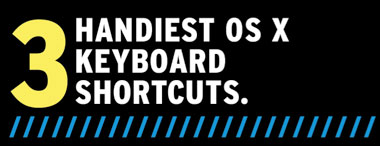
We’re not talking about Command-Z for undo, Command-C for copy, and Command-V for paste--although we’ve practically worn out the Z, P, and V keys, we use those combos so often, and we’re always surprised at how many people don’t know about those easy-peasy ones. No, here are the must-know, tattoo-them-on your-knuckles OS X keyboard shortcuts. And while we’re at it, here’s a quick cheat sheet for deciphering the symbols on keyboard shortcuts lists you find online or in software user manuals and pull-down menus.
GUIDE TO KEYBOARD SYMBOLS

TOP 6 HANDIEST OS X KEYBOARD SHORTCUTS
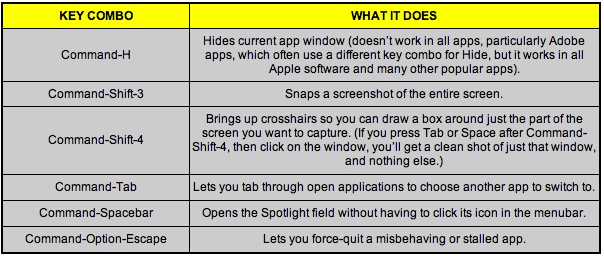

OS X’s command-line utility is called the Terminal. It can be a powerful tool for customizing the way your Mac behaves. Tinkering with the Terminal without a bit of background info isn’t advisable; heed our warnings in our "25 Terminal Tips Every Mac User Should Know" before trying out these basic commands. To launch the Terminal, go to /Applications/Utilities/Terminal, and execute by pressing Return.
FIVE TERMINAL COMMANDS EVERY MAC GEEK SHOULD KNOW
